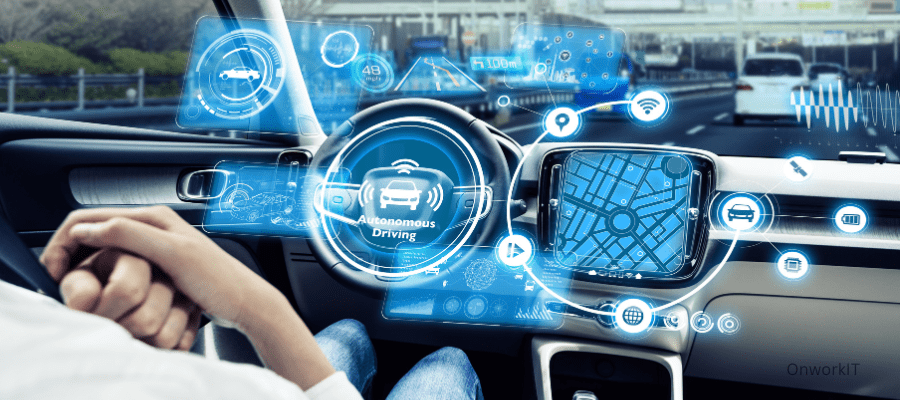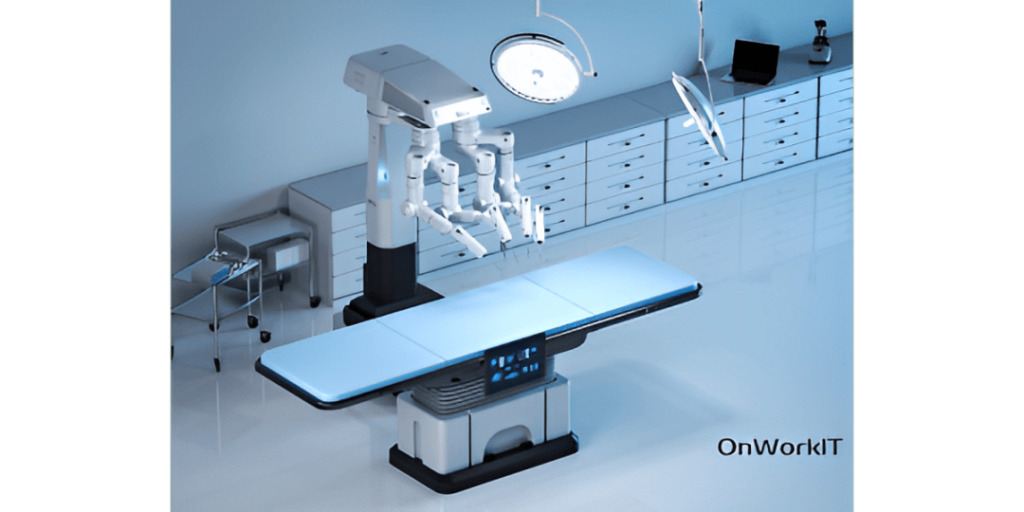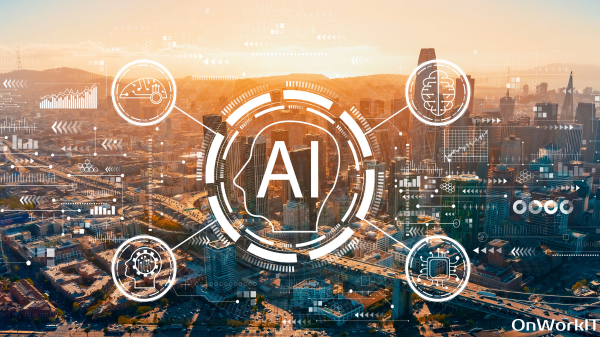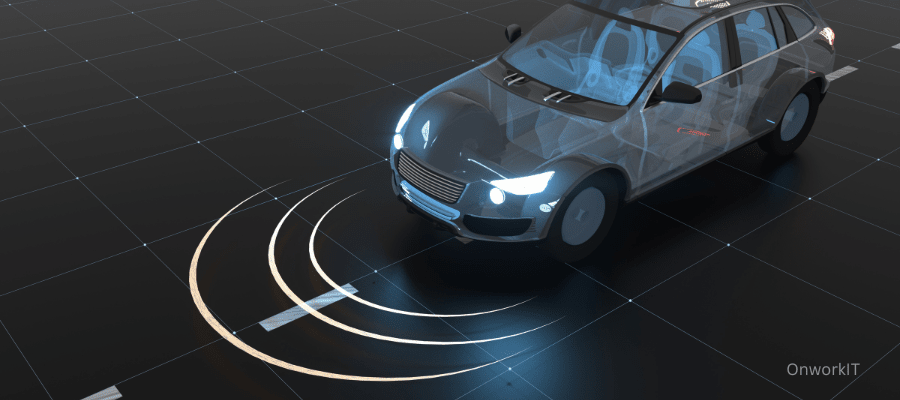All human dreams begin in imagination (Autonomous Vehicle). Science and technology, as distinctly human activities, can only start from uncertainty, doubt, and the spontaneous need to go beyond our limitations.
A century after the invention of the automobile, the world has witnessed technological evolution in this field. The dream began from rudimentary and complex beginnings, gradually paving its way through innovations and groundbreaking advances, reaching the pinnacle of vehicular ambition. Currently, major manufacturers and technological giants are committed to realizing one of science fiction’s greatest desires: autonomous driving.
By definition, an autonomous vehicle is capable of mimicking human driving and control capabilities. As an autonomous vehicle, this machine can perceive its surroundings and navigate accordingly, employing advanced control systems and interpreting sensory information to determine navigation routes, obstacles, and relevant signals. In short, it’s a vehicle that drives itself, an independent machine that doesn’t require direct Human Intervention in executing its tasks.
Development (Autonomous Vehicles)
The automotive industry is one of the largest in the contemporary world. The pace of life and society itself could not exist without the force and impact of vehicular mobility. Cars dominate the universe of roads and cities; their progress has been constant. However, traditional industry magnates have focused mostly on changes in comfort and elegance. Yet, this paradigm is on the verge of being replaced by a new, more exciting, mysterious, and above all, current one. And talking about current trends inherently involves talking about Technology. The new revolution is in the hands of electronic science, where the circuit-chewing little mice commonly known as “engineers” are once again the driving force of innovation. After 40 years of research, “legally” autonomous cars are nearly ready to move beyond the prototype phase. To understand the importance of this progress, one must review the past, present, and future of autonomous vehicles.
History of Autonomous Vehicles
While the most recent advancements have come in recent years, the history of autonomous vehicles is longer than most people realize.
Prototype of an autonomous vehicle

The efforts to create them are not new. In fact, there are already various cars on the market that perform semi-autonomous functions. However, none of them have been fully autonomous, and the prototypes used in testing were nothing more than heavily modified regular cars lacking what is commonly called “aesthetic in creation.”
The landscape is beginning to show the most appealing intentions of companies that have embarked on the quest for a fully autonomous car, designed in a simple and elegant format. The first step in this regard was taken in 2012 by Google, the most important technological company of the time. They astounded the public by showcasing a prototype invented from scratch: capable of reaching a maximum speed of 40 km/h, the prototype represents an extraordinary concept and a complete transformation. It’s dazzling to imagine a car without a steering wheel, brakes, or accelerator, and of course, without a driver. These are replaced by sophisticated software, numerous sensors, and other devices. With just a power button, it’s possible to travel to the destination. Although this format won’t be the first seen officially on the streets, this is mainly due to government policies and laws that require the presence of steering wheels and pedals for safety reasons. However, Google’s daring move demonstrates the true concept of this system and the vast horizon it opens. If the law isn’t ready for such a strong wave now, it surely will be in the near future. Google isn’t alone in this endeavor; Daimler AG, BMW, Renault, Ford, Volvo, Bosch, Delphi, and countless other companies have joined in the conquest of this new vehicle concept.
Operation and Involved Technology
The development of an autonomous car isn’t a standalone event; it’s about integrating various technologies precisely to create a revolutionary vehicle capable of replacing a human driver. Therefore, its operation depends on two essential elements: the “brain” and “vision.” The brain must understand what to do in each circumstance and coordinate the functioning of components and systems such as the accelerator, steering, brakes, gear shifts, and indicators.
The second element is “vision.” While navigating empty highways or simple obstacles may seem straightforward in tests, the reality is complex. Driving through city streets involves seeing traffic lights, avoiding other vehicles, navigating four-way intersections with thousands of cars around, and handling unexpected situations. Vision plays a crucial role here. In Google’s car, the most critical piece is the Light Detection and Ranging (LIDAR) technology, pivotal for light detection and location. Though each manufacturer pursues its own path to full functionality, they all share a common framework of systems.
Sensors of Autonomous Vehicle
LIDAR
For some prototypes, LIDAR is the primary element—a 360-degree “3D laser radar” mounted on the car’s roof. It operates with a range of about 70 to 100 meters. Each revolution provides a point cloud, enabling the computer to generate a three-dimensional image of the surroundings.
LIDAR emits infrared laser beams that bounce off objects and are captured by a camera. However, visibility conditions can affect its performance. LIDAR is considered one of the most precise systems, with an accuracy of approximately ±2 cm, but it can struggle to identify potholes or rocks on the road. One method used measures the time light takes to return after continuous pulse emissions, calculating distances to surrounding objects for quicker responses from nearby elements.
Cameras
Depending on the prototype, cameras can range from conventional video to stereoscopic. Some setups include a central front camera and two corner cameras, focusing on recognizing pedestrians, traffic lights, cyclists, and traffic signals.
Radars
Autonomous vehicles feature several radars, primarily on the front exterior, detecting obstacles up to a hundred meters or more ahead.
Ultrasonic Sensors
These sensors, typically placed on the car’s front, rear, and sides like in the bumpers, measure short distances up to about 5 meters. They primarily complement radars, especially useful for parking maneuvers.
Inertial Measurement Unit (IMU)
Usually on the car’s roof, IMU measures speed changes and angle rotations to understand vehicle behavior.
GPS
A widely known technology, GPS in autonomous vehicles requires enhanced performance, aiming for about 30 cm accuracy.

Conclusion
In essence, the operation of an autonomous vehicle relies on its ability to artificially perceive and respond to its environment using cameras, radars, sensors, and sophisticated processing capabilities. This accumulation of data ensures the vehicle maintains continuous awareness of its surroundings, identifying signals, obstacles, and other vehicles.
Processing
All the information captured by the aforementioned elements must be processed quickly to provide a rapid response that allows the car to act as swiftly as possible. According to studies, the average reaction time for some people to apply the brakes is just under two seconds, while for an autonomous vehicle, it’s as little as three-tenths of a second. This rapid response is enabled by the processing capacity within these vehicles, which typically house around seven dual-core processors, a number that can rise to 17 in some cases.
This underscores that the operation of an autonomous vehicle hinges on its ability to artificially recognize its environment in real-time. It accumulates data redundantly through cameras, radars, sensors, and more, creating a continuous virtual map. This map allows the vehicle to recognize all types of signals, traffic lights, obstacles, and other cars in its vicinity.
Limitations and Operational Challenges
Despite these advancements, autonomous vehicles face limitations. During real-world tests, incidents involving Google’s car have demonstrated certain shortcomings. Notably, these cars can efficiently navigate only pre-programmed and pre-mapped routes. In urban traffic, autonomous vehicles tend to be cautious when suddenly changing lanes or yielding to other vehicles, as they cannot yet reliably predict or anticipate the movements of other cars. This limitation highlights a fundamental challenge: human drivers, even the most experienced, constantly face the dilemma of predicting the movements of other vehicles. The proposed solution to these cases lies in establishing a general system of communication and interconnection between all vehicles, enabling cars to communicate and anticipate each other’s actions, thereby reducing incidents.
Additionally, adverse weather conditions pose significant challenges. Conditions such as heavy rain, snow, fog, or total darkness can hinder the proper functioning of sensors and cameras. Companies like Volvo and Ford are actively working on solutions to mitigate these issues. Volvo, for instance, proposes a system using hidden magnets in roadways to aid in low-visibility situations or sensor failures, while Ford has conducted tests on vehicles in completely dark highways.
Legal considerations also present hurdles. Current legal frameworks are not yet equipped to handle autonomous driving technology. Adapting requires significant changes to traffic laws across different jurisdictions. Ethical considerations related to the decision-making capabilities of machines also come into play, such as scenarios where a vehicle must choose between saving a group of pedestrians or the occupant’s life.
Safety in Autonomous Vehicles
Are humans ready to relinquish control of their vehicles to machines? This question raises profound implications. Human drivers are inherently prone to making fatal mistakes—speeding, running red lights, driving under the influence—leading to tens of thousands of deaths annually worldwide. Autonomous vehicles, programmed to adhere strictly to traffic laws and with faster decision-making capabilities in emergencies, offer a potential solution. However, they are not yet fully ready to replace human drivers entirely.
Conclusion of Autonomous vehicles
The advancement of autonomous vehicles represents a significant technological revolution in transportation. While they offer advantages such as enhanced mobility for the elderly and disabled, reduced traffic congestion, and potentially fewer traffic fatalities due to human error, there are substantial challenges to overcome. These include technical limitations, legal and ethical dilemmas, economic impacts, and the need for gradual societal adaptation to this transformative technology. As the industry continues to refine these vehicles, addressing these challenges will be crucial to realizing the full potential of autonomous driving technology in improving road safety and mobility.









